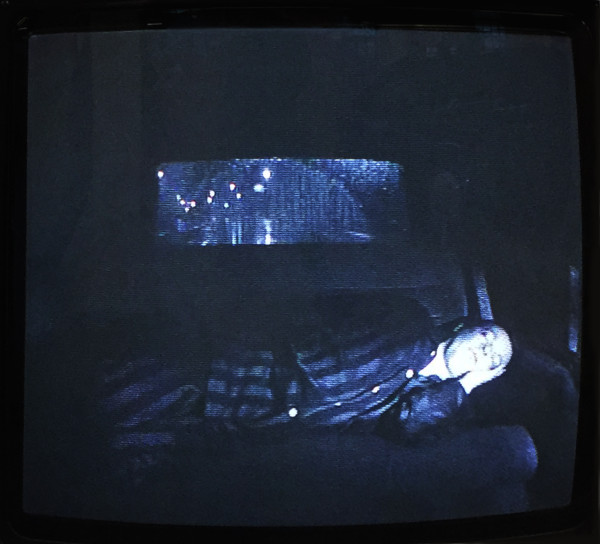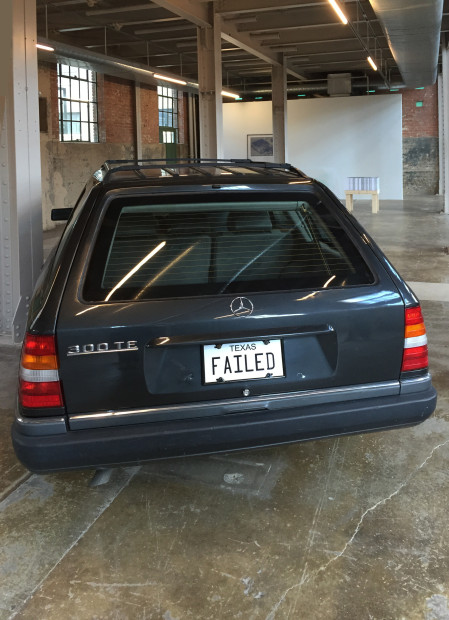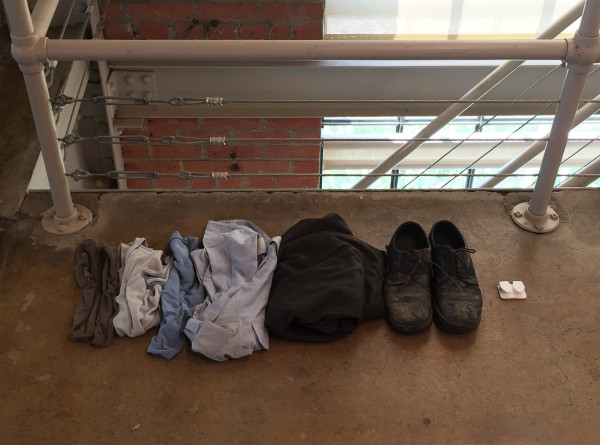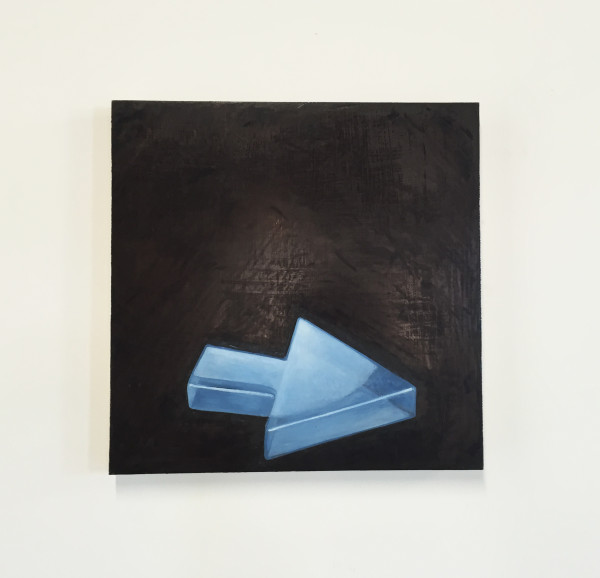Curators Gregory Ruppe and Noah Simblist’s remarkably timely exhibit Emergency Measures opened September 5th at the Power Station in Dallas, after a summer choked with news of bombings, shootings, brutality, and other horrors, and just in time for the 14th anniversary of September 11th. On exactly that day, I went back to see it again, after the opening reception’s crowd was gone, and was struck anew by the phrase “the new normal,” i.e., the constant state of tension and high alert. Borne from the curators’ interest in art works dealing with this contemporary vein of safety and anxiety, this group show is both dense and sparse, muscular and at times beautiful, and showcases a strong range of artists.
The ground floor of the old, converted Dallas Power and Light building opens up to Vancouver-based Rodney Graham’s Halcion Sleep, a career-changing video from 1994, situated quietly off to the left. For almost half an hour, the artist is seen lying asleep across the back seat of a vehicle being driven through rainy night streets. As a single take in real time with no activity other than the changing reflections in the rear windshield behind him, it alternates between dull and menacing; menacing not just for its quoting of noir aesthetics, but for its forced voyeurism and criminal visual parallels of midnight corpse drop-offs, or date rape. Seeking to recreate his earliest childhood memory of the serene, safe feeling of drifting in and out of sleep in the back of his family car, Graham took a heavy dose of the drug Halcion, a benzodiazepine or sedative-hypnotic (chemically similar to Valium, Xanax and Rohyphnol and named after the ill-fated lover of Greek myth) known to evoke “peaceful memories of the past” as the video’s opening credit says, before his brother and a friend loaded him, unconscious, into the car. Graham was interested in the trope of the nighttime car ride from noir films, but part of what’s so unsettling about his adaptation is the reality-spectrum of it—that his video performance is the rare, non-violent, luxury version. There’s also the viewers’ discomfort from watching onscreen inaction in real time. Like Warhol’s 1963 film Sleep, there’s no plot payoff from watching through to the end.
Notably, the drug Graham took was in the news a lot in the early nineties for being taken off the market in many countries after revelations of dangerous side effects (not limited to: disinhibition, de-personalization, hallucinations, paranoia, rage, depression, nausea, and sleep-walking, -talking, -driving, -cooking, -eating, -having sex accompanied by amnesia), and the eventual knowledge that not only was George H. W. Bush coming off the drug when he famously vomited and then fainted on the Japanese prime minister in 1992, he’d been using it throughout his presidency (his U.S. secretary of state James Baker was also a known user). Is it too far-out to ask what role Graham’s chosen drug played in the U.S.’s entry into the first Gulf War, and thus its continuing domino effect? (This is a non-negligible subtext of this exhibit.) To what extent, if any, did Graham seek to embed that into the work?
Just beyond, Jill Magid’s trio of works take over the main space. Based out of New York, Magid—whose practice involves themes of surveillance, safety, secrecy and the state—was in Texas in 2010 to research sniper shootings and by cosmic coincidence, became the key witness to a shooting on the steps of the state capitol in Austin. A constellation of works came from this, including the video The Capitol Shooter: Breaking News, a loop of archived news footage that shows Magid being interviewed repeatedly by various TV news outlets. At first it’s gripping, but it grows painfully absurd by the second or third time you hear the same capsule version of the story from the various newsroom anchors, all wreathed by nearly identical news branding graphics, followed by on-scene reporters asking her the same canned questions. The footage, and her displayed books recounting the events and their aftermath, serve as back-story for her centerpiece, Failed States, her real armored black 1993 Mercedes station wagon. This was once her own car that she used to drive her family. (Shifting attention between this car and Graham’s Halcion Sleep, the realization is bittersweet that in the age of child safety laws, Magid’s offspring, or any others of recent years, will not have that experience of the serene, dreamy magic of lying down in the back of a moving family car.) Upon learning that Mercedes was the maker of choice for armored cars that can “blend in” in Afghanistan (where she was contemplating continuing her own sniper training), she had it armored to B4 level, sufficient to protect it from the capitol shooter’s .44 magnum handgun. It’s no longer street-legal, as all the tags are stripped, which is a pity. The custom-made license plate reading FAILED (or TEXAS FAILED, depending on how you read it), looks heavy-handed for a piece that is otherwise subtly complex and layered with various histories.
That aside, it’s fitting that Magid’s work is center stage here. Not only was her work the starting point of the show for Simblist and Ruppe, but Dallas has a unique place in the history of armored cars. After the 1963 assassination of JFK in an unprotected convertible in downtown Dallas, presidents were no longer ferried in non-armored cars; two days after Kennedy’s death, Oswald was himself gunned down as he was being taken to an armored car at the old municipal building/police department, a mere mile and a half down Commerce Street from this exhibit. Oswald became an inspiration to an unstable Arthur Bremer, who in 1972 gave up on his plan of assassinating Nixon, in no small part because of presidential car bulletproofing, and instead tried to assassinate segregationist Alabama governor George Wallace, who was then running for president. Bremer’s published diaries became the basis of the character DeNiro played in the 1976 movie Taxi Driver, which set off an equally unbalanced John Hinckley Jr., of course also from Dallas. He bought his revolver one block away from the scene of Oswald’s demise, and in a strange twist of fate, it was actually the thick armoring of Reagan’s car that caused the president to be hit in the 1981 assassination attempt. Hinckley was a bad shot and only wounded the president because his last bullet ricocheted off the car. In light of this history, the scars and dings on Magid’s car are thought-provoking.
Along the back wall in the same cyanotype-blue color as Magid’s books, Brazilian artist Lais Myrrha’s printing plate is framed with Portuguese text elucidating the image of another history: a collapsed Oscar Niemeyer building. It’s one of the strongest pieces in the show, and its translated text found in the exhibit literature paints an alternate picture of famed modernist Brazilian state architect Niemeyer’s place in the history of his country, architecture and the corruption of both. Most visible in the U. S. for his design (along with Le Corbusier) of the UN complex in New York (where an estimated 90% of the world’s leaders are meeting this month), Niemeyer is best known worldwide for designing the capital city Brasilia and its striking official structures. In 1971, during the Brazilian dictatorship, his newly commissioned building, called the Palace of Industry, collapsed and killed more than 100 people due to shadiness on the part of the contractors, the politicians, and possibly Niemeyer himself (as Myrrha implies), who claimed only to make the drawings and not the engineering calculations. The most fascinating thing though is the artist’s indication that the disaster was not only swept up, but swept away. No physical trace was left, and no print trace of it either, and it’s hard to find anything online about it. It was even stricken from Niemeyer’s CV for fear that it would damage reputations. Originally part of a much larger installation, the framed wall work holds the printing plate for the picture Myrrha obtained of the building wreckage site, and a plinth-like table holds 2000 copies of the image for the taking, to be put back into the world as a cautionary tale.
Upstairs are three works that are important to the breadth of the show, even if hazier in their reading. Dutch artist Mark Manders’ Assignment, a 2008 collection of carefully folded clothes on the floor by the stairs is tender and fraught with questions. Chief among them: What happened to this person? There is a grouping of humble under- and outer-garments, and other personal items as well. The light blue shirt has faint pit stains, the socks’ heels are gaping holes; shoes are caked in mud. Money is included in the materials list (thought to be bills in the pants pockets), as are contact lenses, although all that’s visible of them is the plastic case. Manders showed this at the DMA a few years ago and according to Simblist spoke of it then in terms of the history of sculpture and fragments of the body; here, he creates something psychologically fragile.
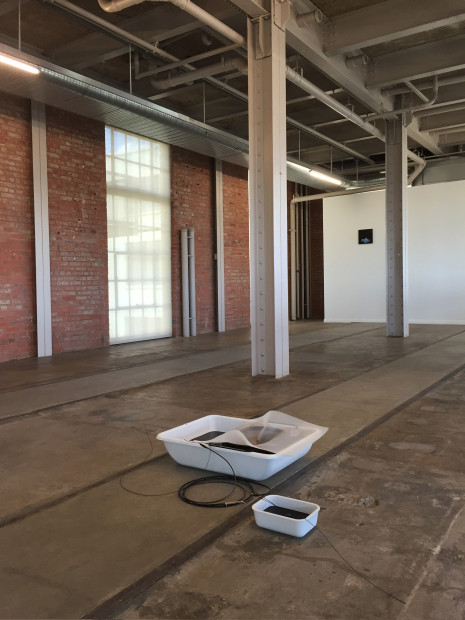
K.r.m. Mooney, Pose-Bin for Still Action, 2014. Polyurethane vessel, water, mild acid compound, cast silver, steel, molasses, chrome-plated grate, bronze, silk.
Halfway across the room is another floor-based, low-profile piece that hovers between sculpture and installation. A chemical vat sits on the ground full of inky-black molasses, partly covered with a metal tray holding a silkscreen mesh weighted by a crude piece of cast bronze with small, linear elements soldered to it. A gangly wire tied to the tray leads via a coiled cable with clip ends to more wires holding unidentifiable metal objects suspended in what looks to be more molasses in another, smaller vat. It’s inscrutable and obstinate, and reminiscent of science-fair potato batteries, witchcraft or homemade bombs. (Now of course one can’t look at it without thinking of the boy recently arrested for his homemade clock in Irving, just a few miles away.) The artist, San Francisco-based K. r. m. Mooney, is engaged in gender issues and works with the idea of porous boundaries. With a background in jewelry work, the artist engages the notion of critical craft. But part of Mooney’s work is in the objects’ placement in a space (floors; overhead), recalling Sandback and his forcing of spatial awareness.
Hung somewhat high on the back wall, R. H. Quaytman’s work here is also subtle. A small painting of a pale blue arrow on a black background reminded Ruppe and Simblist of a softened version of an exit sign’s red emergency indicator: a means of escape. Indeed, Quaytman does use arrows as a way to move people through gallery space, but the shape of the arrow seems more reminiscent of a computer arrow as it mouses across the screen. I like this piece: it has the artist’s signature edges; the blue looks like glass or Jell-o, and the black is practically burnished. Still, it doesn’t carry the gut force of her iconic Hopper-inspired silkscreen of K8 Hardy in the Whitney Breuer building for the 2010 Biennial, which comes from this same chapter of her work.
All the way at the top floor, Berlin-based Israeli artist Alona Rodeh’s seven-minute 2012 video Barking Dogs Don’t Bite is a final, haunting warning cry. It’s an unpopulated street scene, daytime, with the camera trained on what looks to be an empty shop window. With a sudden whoosh, the empty room behind storefront glass suddenly fills with an upside-down column of smoke. Its pluming mushroom soon reaches sideways until it completely fills the room. Meanwhile, alarms blare, an overhead sprinkler is deployed, and it sounds and looks exactly like it is raining inside the space. Security doors lift and lower, but nobody comes. The situation calms, and then, oddly, the action repeats in the night. Later, a lone man inside mops up all the remaining water. He leaves, and the room turns sad and solitary again in the dark, with the lattice shadows of the security walls pulled back down. The credits roll and reveal that the location is a prominent Tel Aviv gallery, making the disinterest of passersby all the more disheartening.
This work, like the others, is urgent and full of pathos. The works in this show inhabit a world where omnipresent new and old dangers, and the futile attempts to establish safety, are the New Normal.
Emergency Measures is at the Power Station, Dallas, through Oct. 9.
Correction 9/24/15: This article originally referred to the artist K. r. m. Mooney using a female pronoun. The artist does not identify with gendered pronouns and the text has been changed to reflect that.


